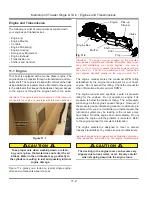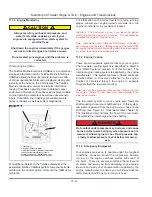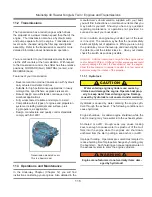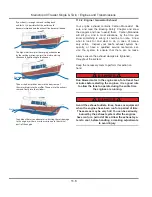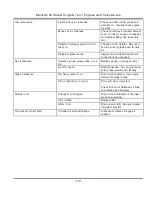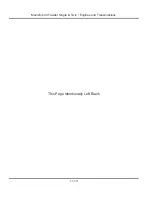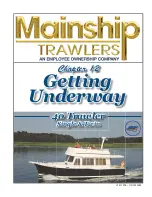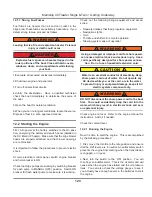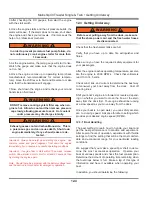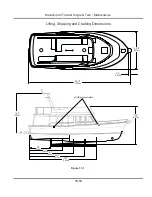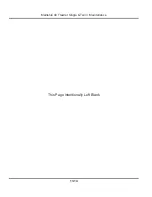
Mainship 40 Trawler Single & Twin • Getting Underway
12.5
Minimum speed for effective steering.
Turning radius at different speeds
Response to steering at slow speeds
Acceleration and deceleration rates
12.3.2 Boat Speed
Boat speed depends on many factors and cannot be
guaranteed. These factors will vary with differing condi-
tions. Some of the factors include the following:
Engine efficiency
Weather conditions
Extra load
Marine growth
Damaged underwater gear
Engines operate most efficiently at the RPM’s stated
in the operating manual for the engine. Efficiency will
decrease if you do not care for and maintain them prop-
erly. If the engine is neglected, power will drop and
speed will decrease. In addition, expensive repairs may
become necessary. Be sure to follow all instructions
in this manual as well as those in the engine operating
manual.
Weather conditions can also affect engine performance.
An increase in engine room temperature from 90 degrees
F to 130 degrees F could result in a 4% decrease in
horsepower. Barometric pressure and humidity also
influence horsepower. The cumulative effect of weather
alone could decrease engine efficiency as much as 10%
on hot days.
The extra load resulting from adding personal equip-
ment, gear, and passengers to the boat may result in a
decrease in speed. The extra load could also be water in
the bilge. A gallon of water weighs 8 pounds. For exam-
ple, twenty gallons of water in the bilge adds 160 pounds
of weight to the boat. This additional weight reduces the
boat’s speed and, when combined with other extra loads,
may significantly reduce performance.
Marine growth on the bottom of the boat will increase
resistance and decrease speed. Increased resistance
increases fuel consumption. Keeping the bottom of the
boat clean will improve fuel efficiency.
Damaged underwater gear (propeller, shaft, struts) can
decrease speed and performance. Such damage is also
likely to cause excessive vibration which can damage
the boat, engine, and other components. If underwater
gear is damaged, avoid operation of the boat and have it
•
•
•
•
•
•
•
•
•
repaired as soon as possible.
12.4 Emergency Operations
12.4.1 Fire
Your boat has a halon (or equivalent) fire extinguisher
system which operates automatically to extinguish a fire
in the engine compartment. The system has an indicator
light on the helm. Moving the switch to ON before start-
ing the engine activates the light. Check this light every
time you start the engine. It shows that the system is
charged and ready to operate.
A loud sound (similar to that of small arms fire) followed
by a “rushing” air sound indicates activation of the extin-
guisher. If the green indicator light goes out or if you hear
the extinguisher discharging, proceed as follows:
* Activating the automatic fire system will automatically
shut down the engine and the generator.
* Evacuate all occupied enclosures immediately. If practi-
cal, evacuate the boat.
* Do not run the blowers.
* Do not open the engine compartment. Allow the halon
fire extinguisher to soak the compartment for at least
fifteen minutes.
DANGER
!
!
Flash fire erupting from the engine compartment
can burn you. Opening the engine compartment will
feed oxygen to the fire and cause the fire to flash
back. Keep engine compartment closed for at least
15 minutes after fire extinguisher discharges.
* Wait for hot metals and fuels to cool before inspecting
for damage or cause of fire.
* Open engine compartment slowly. Have approved por-
table fire extinguisher at hand and ready for use.
Do not breathe fumes or vapors caused by fire. HALON
FUMES ARE TOXIC!
Summary of Contents for 40 Trawler Single
Page 8: ...Mainship 40 Trawler Single Twin Operator s Manual H This Page Intentionally Left Blank ...
Page 14: ...Notes Mainship 40 Trawler Single Twin Introduction 1 6 ...
Page 18: ...2 4 Mainship 40 Trawler Single Twin Documents and Forms Fig 2 1 ...
Page 23: ...2 9 Mainship 40 Trawler Single Twin Documents and Forms Notes ...
Page 24: ...2 10 Mainship 40 Trawler Single Twin Documents and Forms This Page Intentionally Left Blank ...
Page 33: ...3 9 Mainship 40 Trawler Single Twin Warranty SAMPLE ...
Page 35: ...3 11 Mainship 40 Trawler Single Twin Warranty SAMPLE ...
Page 36: ...Notes 3 12 Mainship 40 Trawler SIngle Twin Warranty ...
Page 37: ...V1 011508 P N 1034082 40 Trawler Single Twin Single Twin Boating Safety Safety Chapter 4 ...
Page 54: ...Mainship 40 Trawler Single Twin Boating Safety 4 18 Notes ...
Page 66: ...Notes Mainship 40 Trawler Single Twin Fuel System 5 12 ...
Page 76: ...Notes Mainship 40 Trawler Single Twin Underwater Gear 6 10 ...
Page 92: ...Mainship 40 Trawler Single Twin DC Electric Systems 7 16 Notes ...
Page 102: ...Mainship 40 Trawler Single Twin AC Electric Systems 8 10 This Page Intentionally Left Blank ...
Page 110: ...Mainship 40 Trawler Single Twin Water Systems 9 8 Notes ...
Page 146: ...Mainship 40 Trawler Single Twin Maintenance 13 14 This Page Intentionally Left Blank ...
Page 151: ......
Page 152: ......
Page 153: ......
Page 154: ......
Page 155: ......
Page 156: ......
Page 157: ......
Page 158: ......
Page 159: ......
Page 160: ......
Page 161: ......
Page 162: ......
Page 163: ......
Page 164: ......
Page 165: ......
Page 166: ......
Page 167: ......
Page 168: ......
Page 169: ......
Page 170: ......


